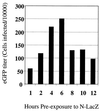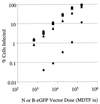Abrogation of Ref1 retrovirus restriction in human cells
- PMID: 11836433
- PMCID: PMC153820
- DOI: 10.1128/jvi.76.5.2548-2550.2002
Abrogation of Ref1 retrovirus restriction in human cells
Abstract
We have previously described postentry restriction of murine leukemia virus in mammals. Here we characterize the block in human cells. Restricted infection kinetics are multiple hit at high virus dose, and restriction is abrogated by preexposure to restricted virus. We hypothesize that restricted capsid can titrate out the restriction factor.
Figures





References
-
- Best, S., P. Le Tissier, G. Towers, and J. P. Stoye. 1996. Positional cloning of the mouse restriction gene Fv1. Nature 382:826-829. - PubMed
-
- Decleve, A., O. Niwa, E. Gelmann, and H. S. Kaplan. 1975. Replication kinetics of N- and B-tropic murine leukemia viruses on permissive and nonpermissive cells in vitro. Virology 65:320-332. - PubMed
Publication types
MeSH terms
Substances
Grants and funding
LinkOut - more resources
Full Text Sources
Other Literature Sources
Research Materials
Miscellaneous

